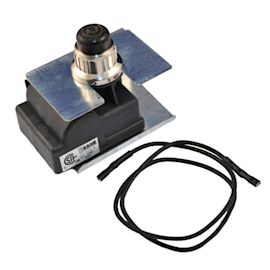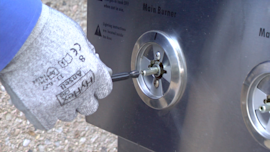The secret to great grilling


Gas grills come with a lot of different features these days, but the basics of how to cook food on a grill never change. If you’re a newbie to a gas grill or just want a refresher, check out these tips for preparing and loading a grill, whether to use direct vs. indirect heat, what are safe internal temperatures for cooked meat and more.
Check out our other great grilling videos about what to do if your grill heats unevenly, how to prevent grease flare-ups and four ways to check how much propane is left.
Preparing to grill
Your favorite food is at room temperature and ready to throw on the grill. But wait! Is your grill ready for the food? If your gas grill has stainless steel or cast iron grates, remember to season them before you preheat. Seasoning helps prevent rust and makes your grill easier to clean. Plus, it’s easy to do—with the grill burners turned off and the grates cold, coat the grates evenly with canola or peanut oil, and then wipe off any excess with a paper towel. That’s it. Your grill is ready for preheating.
Preheating ensures that meat cooks evenly and thoroughly, and also burns off residue left from previous use. With the lid open, turn the heat setting for all the burners to the hottest temperature and then close the lid. Let the grill warm up for about 15 minutes or until all the oil burns off.
While the grill is preheating, take a minute to think about whether the food you’re going to cook needs direct or indirect heat.
Grilling with direct heat
Direct heat is pretty much what it sounds like—cooking food directly over lit burners on your gas grill. The process is ideal for searing and gives meat, poultry, fish or vegetables an open-flame barbecued taste with the grill marks to prove it.
Direct heat is best for foods that take less than 25 minutes to cook. Turn the food over half way through cooking so it cooks evenly, but make sure to use a spatula or tongs to flip meat rather than a fork because stabbing the meat can result in loss of juices (read: flavor).
Your gas grill likely has multiple burners, so use them to your advantage depending on the food you’re cooking.
High heat—and fast cooking—is good for thinner cuts of meat and smaller items like kebabs, steaks, chops, burgers and hot dogs.
Fish, chicken, vegetables and fruit are better grilled at medium heat.
Turn one burner to high heat and another to medium heat if you’re cooking different types of meats and vegetables. You can even keep a third burner off to use as a safety zone, in case you need to move food off heat quickly. Of course, many grills also come with warming racks or drawers that allow you to keep food warm while you finish cooking.
Grilling with indirect heat
When you grill with indirect heat, you’re basically baking the food. Indirect heat is for foods that need to cook for a longer time, such as roasts, whole poultry, ribs and other large cuts of meat. Indirect heat ensures that you can cook the food thoroughly without burning the outside. Because the food cooks more slowly, you don’t have to turn the food. Close the lid when using indirect heat to keep the heat inside the grill.
To cook food indirectly on a gas grill, preheat all burners for about 15 minutes and then turn off the burners that sit directly under what you’re going to cook. If you have a large, multi-burner grill, this approach might mean the left and right burners stay on, while the middle burner is off. Or, one side on, one side off. As long as the meat sits above the burner or burners that aren’t lit, the meat cooks using the indirect heat from the other, lit burner or burners.
Gas grills come with a lot of different features these days, but the basics of how to cook food on a grill never change. If you’re a newbie to a gas grill or just want a refresher, check out these tips for preparing and loading a grill, whether to use direct vs. indirect heat, what are safe internal temperatures for cooked meat and more.
Tip: Get the best of both worlds by searing larger cuts of meat first using direct heat—or a sear burner if your grill comes with that option. To sear meat, start with the grill as hot as it goes. Grill the meat for 2 to 3 minutes on one side and then flip over and sear for another 1 to 1-1/2 minutes. The meat should have a crisp, browned crust. Now you can move the meat to indirect heat to roast slowly. This method lets you cook moist, tender meat at lower temperatures without burning the outside.
Cooked meat temperature
Whichever grilling method you choose, always cook meat thoroughly to kill any bacteria that might be on it, so the meat is safe to eat. Meat and poultry cooked on a grill often brown fast on the outside, so measure internal temperatures with a food thermometer.
Here are the U.S. Department of Agriculture’s minimum internal temperatures for cooked meats (all temperatures are Fahrenheit).
Poultry and ground poultry: 165 degrees
Ground pork, beef, veal and lamb: 160 degrees
Beef, pork, lamb and veal (steaks, roasts and chops): 145 degrees (allow meat to rest at least 3 minutes before eating to let juices thicken and reduce splatter when you cut the meat)
Fish and shellfish: 145 degrees
Cook foods completely the first time to destroy harmful bacteria; never partially grill meat or poultry and finish cooking later. When reheating fully cooked meats like hot dogs, grill to 165 degrees or until steaming hot.
When the meat is cooked and you’ve taken it off the grill, let it rest for a few minutes to allow the internal juices to thicken and redistribute. Doing so reduces the amount of juice spilling or splattering from the meat when you cut into it.
If you want your meat to be hot and sizzling at serving time, let it sit for a few minutes after it’s thoroughly cooked, then pop it back onto the grill over the highest heat possible just before serving. Sear it for 30 seconds per side, and you’ll end up with a perfectly rested, juicy meat and a crisp, sizzling crust.
Other grilling options
Here are just a few of the different features found on gas grills that can add to your grilling experience.
An infrared burner has extremely high heat (over 1,300 degrees) to sear meats and caramelize fruit. Typical burners don’t reach these temperatures. An infrared burner heats an object, often a ceramic grate, which quickly reaches searing temperature. The grate, not the fire, sears the food.
Side burners let you expand your cooking area to heat up sauces or boil water without making extra trips to the kitchen. Some side burners also are sear burners.
Warming drawers keep cooked food warm while everything else finishes cooking.
A rotisserie attachment allows meat to cook slowly and more evenly using indirect heat. A rotisserie is a spit or a heavy metal rod inserted through the meat and turned by a motor near the fire. As the rotisserie turns the meat, the meat bastes in its own juices.
Combination gas/charcoal grills give you the convenience of a gas grill but let you use charcoal when you want that charcoal flavor. A combo grill really is the best of both grilling worlds.
Is your mouth watering yet? Time to get grilling!
Symptoms for gas grills
Choose a symptom to see related gas grill repairs.
Main causes: nearly empty fuel tank, faulty pressure regulator, burner tube clogs, bad burner tube alignment to gas valv…
Main causes: empty fuel tank, tripped flow-limiting device on the pressure regulator, faulty manifold valves, burner tub…
Main cause: worn wheel…
Main causes: damaged or dirty flame tamers, corroded firebox, accumulated grease and debris in the grease pan…
Main causes: clogged burner tubes, cracked insulators on igniter electrodes, wiring failures, bad ignition module, manif…
Repair guides for gas grills
These step-by-step repair guides will help you safely fix what’s broken on your gas grill.

How to replace a gas grill wheel
Replace a broken or damaged wheel in less than 15 minutes.…

How to replace a gas grill igniter electrode
Replace the igniter electrode on your gas grill if it won’t light the burner.…

How to replace a gas grill ignition module
Follow these steps to replace the ignition module if it doesn't produce a spark. …
Articles and videos for gas grills
Use the advice and tips in these articles and videos to get the most out of your gas grill.

Learn about all the convenient features on our Sears PartsDirect website that make your parts purchases easier.…

Get answers to frequently asked questions about Sears and Sears PartsDirect.…

A conversion kit and a few simple tools are all you need.…